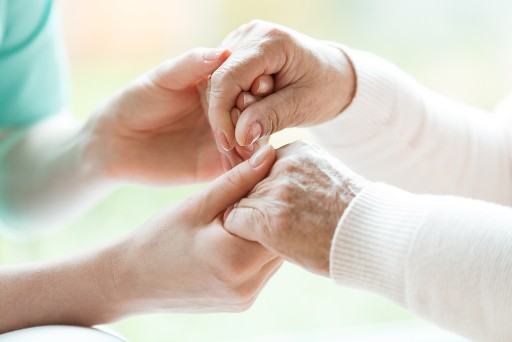Older adults move into independent living for reasons that often have nothing to do with health care: Seniors want the option of no longer being responsible for the cooking or cleaning, they no longer want to maintain a home, or they want easier access to wellness and socialization opportunities.
Knowing when it’s time for assisted living, however, often isn’t so clear. Understanding health care options for seniors can be confusing. And choosing from among the many options can be especially overwhelming when family members, not the senior, are choosing the care.
Yet it’s important to familiarize yourself with both the health care options for seniors and the independent living choices in your area. It’s also a good idea to do your research on both independent living and assisted living well before you ever need an assisted living facility. As many senior living residents will tell you, it’s better to move one day too early instead of one minute too late.

When is it time for independent living?
Once you’re ready to let go of all the responsibilities of homeownership – and have someone take care of maintenance, meal preparation, housekeeping, yardwork, snow removal, transportation and then some – you’re ready for independent living. Because as the name suggests, independent living communities are residential settings that allow you to live a more fulfilling independent life, without the hassles of home maintenance. Most independent living communities offer services and amenities designed to make each day more convenient, enjoyable, and purposeful.
When you start looking at independent living communities, you’ll have some options to choose from, too, from 55+ communities to Life Plan Communities, also called Continuing Care Retirement Communities, or CCRCs.
55+ communities – Also called age-restricted communities or active adult communities, these are complexes restricted to people who meet a certain age criterion. Your independent living residence could be an apartment, condo, duplex or single-family home which you might rent or own, depending on the community. Usually, services like exterior maintenance and lawn work are taken care of and paid for through Homeowners’ Association (HOA) dues, but residents are responsible for interior maintenance and housekeeping. There are amenities and organized activities available around the community’s common spaces for residents to enjoy (think of spaces like a pool, golf course or clubhouse). Depending on the community, they may or may not be dining services on-site, so you’ll still have to cook your own meals. And there is no care on-site to allow you to age in place. So, if you need any type of care – from assisted living and skilled nursing to memory care or rehabilitation – you’ll have to move out of the community temporarily or permanently. And keep in mind, as for everything, costs vary widely between these types of communities in terms of monthly rent, HOA dues and other fees they may require.

A Life Plan Community/CCRC is a community that offers independent living, plus multiple levels of care, all in one place. If you choose a Life Plan Community as an active older adult, you move into independent living, where you’ll enjoy your private independent living residence, a variety of services and amenities, and neighbors who have had similar life experiences as you. Together, it all adds up to a remarkable opportunity to enjoy a vibrant lifestyle. Often, you’ll find these types of services and amenities available to you:
- Full calendar of social, recreational and educational programs
- Comprehensive health and wellness program
- Chef-prepared meals
- All interior and exterior maintenance
- Housekeeping and flat linen service
- Around-the-clock security
- Numerous common spaces such as a library, chapel, beauty salon and barbershop, woodworking shop, fitness center, gardens and walking paths
Life Plan Communities usually require a one-time, upfront entrance fee and monthly fee. The entrance fee may cover some of the costs of care you may need and may be partially or entirely refundable. The monthly fee, which isn’t refundable, is a fee you pay every month to cover the cost of the services and amenities the community offers. If the time comes when you experience a change in health and you need a higher level of care, whether it’s assisted living, skilled nursing, memory care or rehabilitation, you’ll have access to that care right on-site, so additional moves won’t be necessary. However, costs vary widely among Life Plan Communities depending on what type of contracts they offer, so be certain to educate yourself and your family members fully before you make a decision.
When is it time for assisted living?
You may have lived just fine in your home for many years, but recently you’re noticing some changes. You struggle to carry your basket full of dirty clothes down the stairs to the laundry room. Or you’re having a harder time getting to the grocery store, then bringing in bags of groceries from the car to your kitchen. Or perhaps you realize you’re forgetting to take some of your daily medications. Perhaps your family members are worried that you’re not eating as healthy as you should be, or that you’re not keeping your home as clean and tidy as you always did before.
These may be telltale signs that you may need more help managing some of the Activities of Daily Living, or ADLs… But you should know assisted living isn’t just for older adults who have fallen or who have more serious health needs that require more care. Actually, there are many health benefits to moving to assisted living at a senior living community:
- Communities help reduce social isolation and feelings of loneliness.
- Professional, compassionate care is always available if you need it.
- You may actually maintain your independence longer – and with activities and amenities, you’ll be able to explore a more purpose-filled lifestyle.
- You’ll have more free time without the worries of making meals, housework or maintenance – because it’s done for you!

Assisted living provides residents assistance with ADLs like:
- Bathing – Showering or bathing, washing body and hair, brushing teeth, shaving, trimming nails, combing hair
- Dressing – Putting on undergarments, pants, dresses, sweaters, socks and shoes; managing buttons or zippers
- Transferring – Rising from bed, standing up, sitting down or moving from a bed to a chair, walking from one place to another
- Toileting – Sitting on and rising from the toilet, cleaning self afterward and washing hands
- Continence – Controlling bladder and bowel functions, or self-managing incontinence
- Feeding – Getting food from plate to mouth
You or a loved one may need help with one ADL, such as managing your medications, or you might need help getting dressed for your day but then you’re ready to go. That’s also the type of help you’ll find at an assisted living community.
As an independent living resident at Oak Trace, you don’t have to move to assisted living to receive a bit more help. For an additional fee, we offer Lifespace Personal Care Services, which offers trained, vetted caregivers who provide help with ADLs to residents in their independent living residences. They also provide cooking, light housekeeping, transportation, companionship and more. Each resident’s level of service is customized to their personal preferences and needs. And as needs change with time, so do the services.
If you’ve started looking into whether assisted living is right for you, or for someone you love, start with assisted living at Oak Trace. Call us at 1.888.679.2568 or fill out the form on this page to start the conversation.


